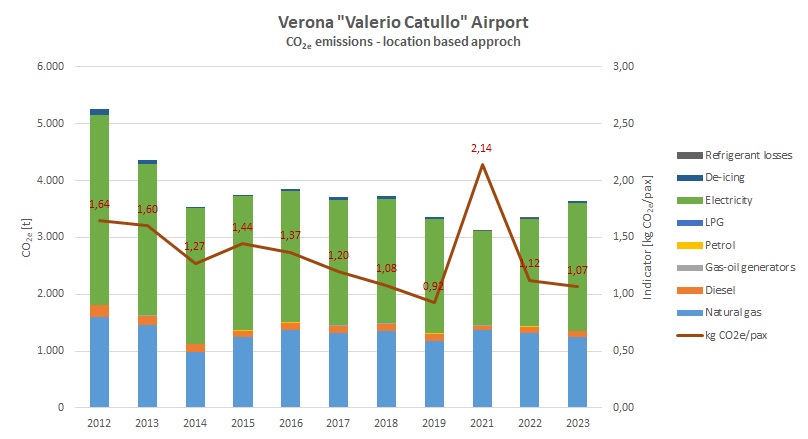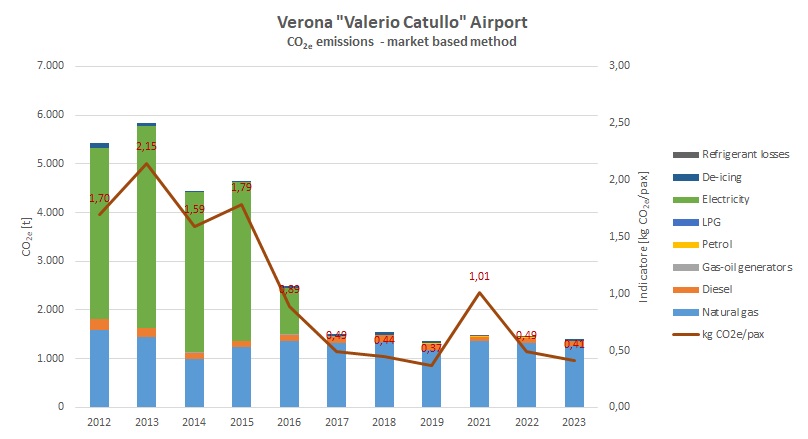In 2009, ACI EUROPE launched the Airport Carbon Accreditation (ACA), a voluntary programme for assessing and recognising the efforts of participating airports in managing and reducing their greenhouse gas emissions. As of late 2014, this initiative was expanded world-wide.
Verona airport joined it in 2016 applied for this program through the "Reduction" level and then in 2024 upgrade to “Neutrality” level.
Valerio Catullo Airport Company of Verona Villafranca S.p.A. has thus started a journey aimed at fighting climate change by signing a dedicated policy with the aim of the airport more sustainable, thereby reducing its Carbon Footprint.
Depending on the operational and organisational boundaries of the airport, emissions are categorised as follows:
- Scope 1/direct emissions: emissions from the direct combustion of fossil fuels purchased for heating, electricity and heat production, vehicles and equipment refuelling. These sources are generally owned and directly controlled by the organization;
- Scope 2/indirect emissions from energy consumption: emissions from the generation of electricity imported and consumed by the organization for the operation of electrical equipment, heating and lighting inside buildings; the importer is indirectly responsible for the emissions generated by the supplier for the production of the required electricity;
- Scope 3/other indirect emissions: all other indirect emissions. These are a consequence of the activities of an organization but arise from sources owned or controlled by other organizations. By way of example, emissions related to business travel, employee commuting, the LTO cycle of aircraft, etc., take part of this category. These are emissions that an airport management company can guide and influence.
The program has adopted the GHG Protocol Scope 2 Guidance according to which there are two ways of reporting Scope 2 emissions: the location based approach and the market based approach. The first approach reflects the average electricity emissions of the country or region where the airport is located and uses a specific average emission factor from the grid. The market-based approach instead reflects the emissions from electricity sources and products that have been purposefully chosen and allows for the use of an emission factor that is directly associated with the type of electricity purchased.
Through the monitoring and analysis of the data, the results obtained relating to the Carbon Fooprint are reported below.

N.B. As defined by Airport Carbon Accreditation, in order to maintain the integrity of the programme during the emergency period caused by COVID-19, the 2020 emissions data were excluded from the calculation.


For 2023, the offsetting of scope 1 and 2 residual emissions (according to the market-based approach) as well as scope 3 airport operator staff business travel emissions amounted to 1,410 tCO2e.
The supported offsetting project is part of the Verified Carbon Standard (VCS) program and its identification number is 1485 (Chorokhi Hydro Power Plant Project). It concerns a hydroelectric plant located on the Chorokhi River, in the city of Batumi in Georgia. Total installed capacity is 98.731 MWe with an expected annual electricity generation of 410.8 GWh.
The credits cancellation can be verified in the Verra register while the certificate can be viewed here.
Verona Airport has developed a decarbonization plan to achive the level "Net Zero Carbon Emissions" for Scopes 1 and 2 by 2045.